



October 2013
Europa
At NASA's Goddard Space Flight Center in Greenbelt, Maryland, scientists have been studying data sent back from the Galileo spacecraft in the late 1990's. They have been trying to figure out why the cracks in the ice on the moon Europa have changed over time.
Three main theories have been put forth. One is the rotation of the ice sheet itself, in that the ice shell rotates faster than the moon orbits Jupiter. The second theory is that Europa has a tilted axis. The third theory is that the differences are just random.
The latest findings point to the second theory, Europa has a tilted axis. The cracks are caused by tidal forces as Europa orbits Jupiter. At its closest point to Jupiter, Europa gets stretched raising the ocean height over 100 ft (30 meters). When the moon moves to its farthest point from Jupiter, the forces are diminished and the moon relaxes. All of this causes the ice to crack under the strain. But one would think that the cracks would all run in the same direction. They do not. But if Europa had a tilted axis, then the directions of the cracks can be explained.
Galileo did not return information on the tilt, or procession, of Europa. This data will have to be left to a future mission to the moon. Tidal forces keep the oceans warm to remain liquid. A tilt of the moon's axis will contribute to this producing even more heat.
Cracks in the ice of Europa near the equator.
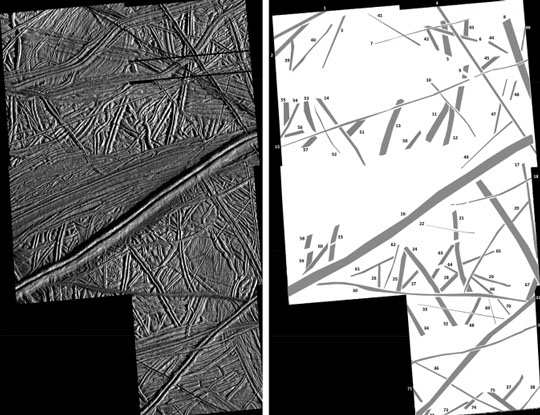
Milky Way's Bulge
The center of the Milky Way has a bulge. For the first time, scientists have been able to create a 3D map of the center of the Milky Way. Our galaxy has a 'bulge' at its center in the shape of a peanut shell. This bulge contains around 10 trillion stars and is thousands of light years across. It is located about 27,000 light years from us.
Because of the dust and gases at the center of our galaxy, scientists had to turn to using data obtained from other wavelengths such as UV and infrared. Scientists used the VVV near-infrared survey from the Vista Telescope at ESO's Paranal Observatory in Chile. This survey picked up stars 30 times fainter than previously found. By using a total of 22 million red giants they were able to determine distances. Red giants were chosen because they have well known properties that allow their distances to be calculated. Their luminosity is independent of their age or composition.
A second team in Chile used the MPG/ESO 2.2 meter scope to measure tiny shifts due to the motions of the bulge stars. Combined with measurements of the motion of the stars toward or from earth, they were able to map the stars in three dimensions.
Similar peanut shell shaped structures have been found in other galaxies. Astronomers think that the Milky Way was originally a pure disk of stars which formed a flat bar billions of years ago. The inner part then buckled to form the peanut shape we see today.
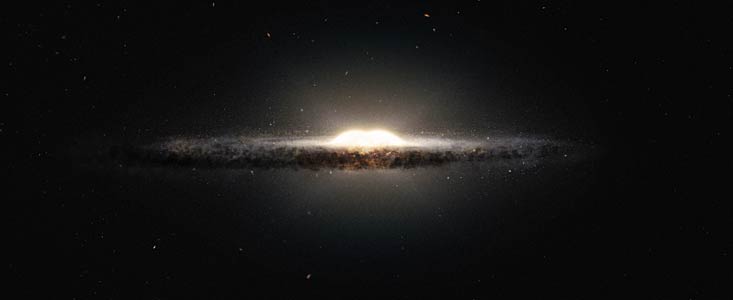
Visit our sponsors.
IMAGE CREDIT: NASA, JPL-CalTech, University of Arizona, Goddard
For advertising opportunities on this page and our videos, contact
Upcoming Launches
No October launches scheduled
Date: November 6
Launch Vehicle: Soyuz 37
Launch Site: Baikonur Cosmodrome, Kazakhstan
Description: Soyuz 37 will carry three Expedition 38/39 crew members to the International Space Station
Image Credit: ESO
Bizarre Nebulae
ESO's New Technology Telescope and the Hubble Space Telescope have been observing more than 100 planetary nebulae in the central bulge of the Milky Way (see the article above for more on the bulge). Scientists have found that butterfly shaped nebulae in this region are mysteriously aligned.
Planetary nebula are formed when a star at the end of its life blows off its outer layers of gas and dust into space. Planetary nebulae are put into three types; elliptical with an aligned internal structure, elliptical without an aligned internal structure and bipolar. It is the bipolar nebulae that produce the butterfly or hourglass shape.
These nebulae are all formed in different locations and have different characteristics. They do not interact with each other. One would expect that they would appear random in space. Two of the types do appear randomly, but the bipolar type line up in the same way. Many of the bipolar nebulae light up with their long axis aligned along the plane of our galaxy.
This alignment indicated something bizarre about the star systems at the central bulge of the galaxy. 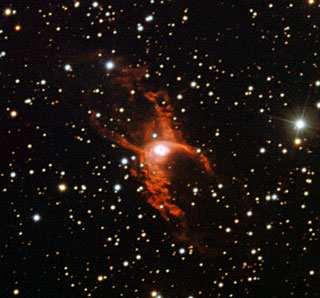 The nebulae would have to be rotating perpendicular to the interstellar clouds from which they formed, which is very strange. This indicates the bulge may have more influence over the galaxy than thought. Strong magnetic fields may be the reason as they could have created an orderly behavior of the planetary nebulae.
The nebulae would have to be rotating perpendicular to the interstellar clouds from which they formed, which is very strange. This indicates the bulge may have more influence over the galaxy than thought. Strong magnetic fields may be the reason as they could have created an orderly behavior of the planetary nebulae.
Nebulae closer to us, outside the central bulge do not line up in any orderly fashion. So the cause lays in something at the heart of our galaxy.
Image Credit: ESO
LADEE
The Lunar Atmosphere and Dust Environment Explorer (LADEE) lifted off Friday September 6th from NASA's Wallops Flight Facility on Wallops Island, VA aboard a Minotaur V rocket. LADEE is the first spacecraft designed in the Bus architecture which is designed to incorporate a system allowing NASA to build, test and assemble multiple modules at the same time. The same common bus can be used for different missions making it a multi-use system.
On Sept. 21 the main engine burn successfully placed the spacecraft on the required phasing loop orbit to arrive at the moon on Oct. 6th. The Lunar Dust Experiment (LDEX) completed initial activation tests, so all of the spacecraft's instruments have now been checked out after launch.
When arriving at the moon, LADEE will begin a 40 day commissioning phase where it will be in high lunar orbit. Activities will include testing a high-data-rate laser communication system. After commissioning, LADEE will begin a 100 day science mission to collect data about the moon. Three instruments will determine the composition of the the thin lunar atmosphere and remotely sense lofted dust, measure variations in the chemical composition of the atmosphere, and collect and analyze samples of lunar dust particles in the atmosphere. 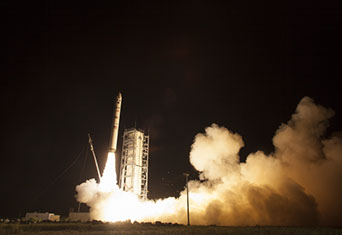 Scientists hope to answer the question if lunar dust, electrically charged by the sunlight, was responsible for the pre-sunrise glow above the lunar horizon witnessed by the Apollo astronauts on several missions.
Scientists hope to answer the question if lunar dust, electrically charged by the sunlight, was responsible for the pre-sunrise glow above the lunar horizon witnessed by the Apollo astronauts on several missions.
The results will also help scientists understand other objects with similar characteristics such as large asteroids, Mercury and the moons of the outer planets.
Image Credit:NASA/Carla Cioffi
NuSTAR
NASA's Nuclear Spectroscopic Telescope Array (NuSTAR) is in search of Black Holes. The spacecraft has a mast of 10 meters, the length of a school bus and is designed to measure high energy X-Rays. The receiver gathers X-Rays of different wavelengths and focuses them down the mast in never before seen sharpness.
NuSTAR recently investigated its first 10 supermassive black holes. Over the course of its two year mission it is expected to study hundreds of black holes as well as search the universe for new objects. By using the higher wavelengths, NuSTAR can see through thick clouds of gas and dust that previous scopes could not. NuSTAR will be able to find the most hidden supermassive black holes.
Combining this data with lower energy X-Ray data from NASA's Chandra and ESA's XMM-Newton, scientists will gain a deeper understanding of how black holes function and how they are formed.

An optical color image of galaxies is seen here overlaid with X-ray data (magenta) from NASA's Nuclear Spectroscopic Telescope Array (NuSTAR).
NuSTAR's serendipitous discovery in this field, indicated by the arrow, lies to the left of a galaxy, called IC751, at which the telescope originally intended to look. Both magenta blobs show X-rays from massive black holes buried at the hearts of galaxies.
The optical image is from the Sloan Digital Sky Survey and a color composite of images over three different optical wavebands (the G, R, and I bands). The NuSTAR data shows X-rays in the 3 to 24 keV energy range.
Image credit: NASA/JPL-Caltech
Prawn Nebula
The VLT Survey Telescope at ESO's Paranal Observatory in Chile has taken the sharpest picture ever of the Prawn Nebula (IC 4628). Located in the constellation Scorpius, 6000 light years from earth, the Prawn Nebula is a huge stellar nursery of newborn stars.
The new stars are best seen in the ultraviolet wavelengths. The ultraviolet light from the stars causes the gas around them to glow. The radiation strips the electrons from the atoms which later recombine and release energy in the form of light. The color of the glow depends on the elements in the gas. Hydrogen glows red.
The Prawn Nebula is about 250 light years across, about the area four times the size of a full moon. But the light emitted in the visible spectrum, which we can see with our eyes, is very faint.
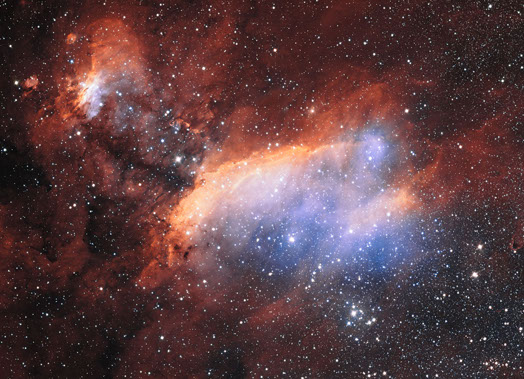
Image Credit: ESO
© 2014-2016 Ted Cook Productions LLC. - All Rights Reserved